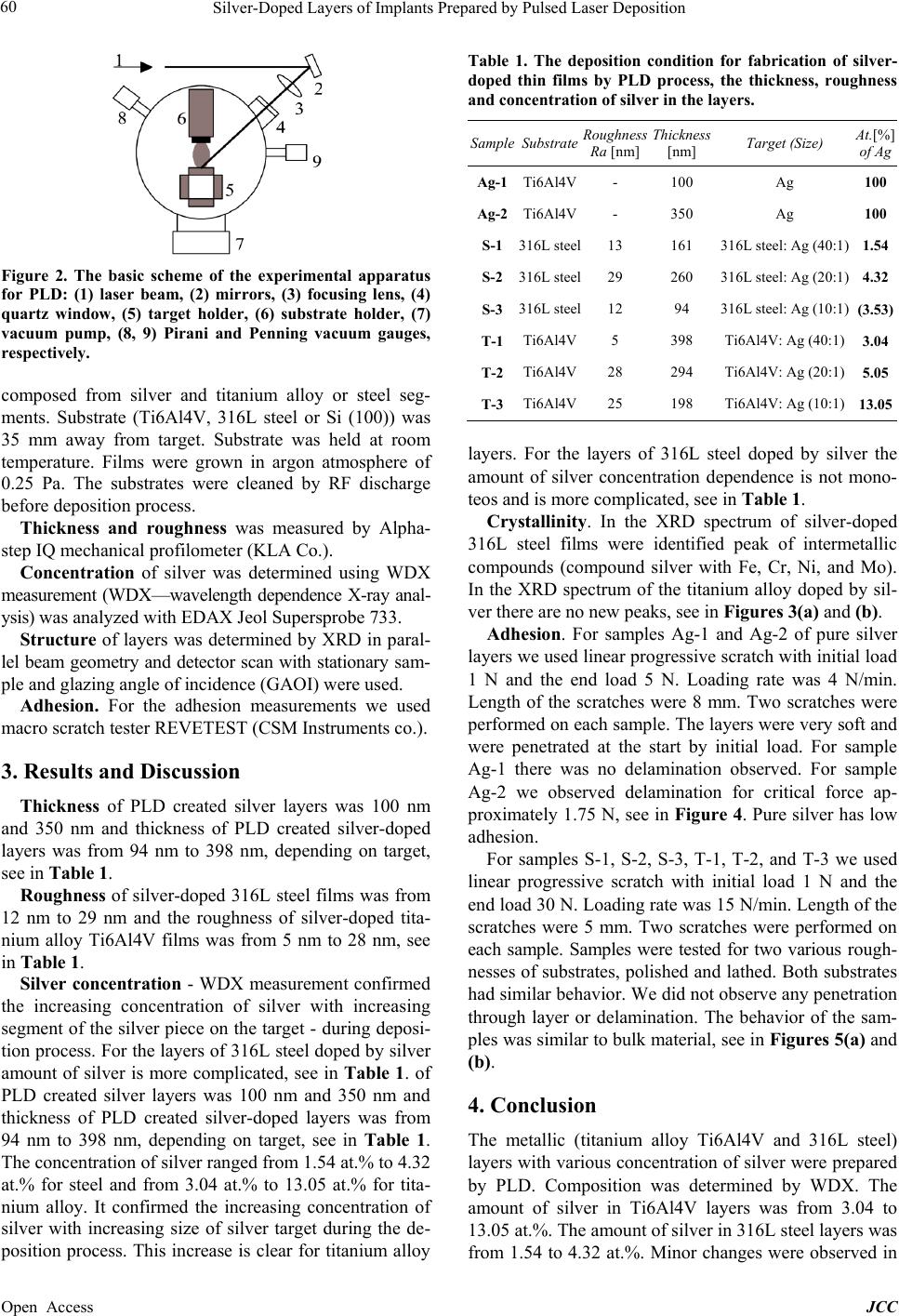
Silver-Doped Layers of Implants Prepared by Pulsed Laser Deposition
Open Access JCC
Figure 2. The basic scheme of the experimental apparatus
for PLD: (1) laser beam, (2) mirrors, (3) focusing lens, (4)
quartz window, (5) target holder, (6) substrate holder, (7)
vacuum pump, (8, 9) Pirani and Penning vacuum gauges,
respectively.
composed from silver and titanium alloy or steel seg-
ments. Substrate (Ti6Al4V, 316L steel or Si (100)) was
35 mm away from target. Substrate was held at room
temperature. Films were grown in argon atmosphere of
0.25 Pa. The substrates were cleaned by RF discharge
before deposition process.
Thickness and roughness was measured by Alpha-
step IQ mechanical profilometer (KLA Co.).
Concentration of silver was determined using WDX
measurement (WDX—wavelength dependence X-ray anal-
ysis) was analyzed with EDAX Jeol Supersprobe 733.
Structure of layers was determined by XRD in paral-
lel beam geometry and detector scan with stationar y sam-
ple and glazing angle of incidence (GAOI) were used.
Adhesion. For the adhesion measurements we used
macro scratch tester REVETEST (CSM Instruments co.).
3. Results and Discussion
Thickness of PLD created silver layers was 100 nm
and 350 nm and thickness of PLD created silver-doped
layers was from 94 nm to 398 nm, depending on target,
see in Table 1.
Roughness of silver-doped 316L steel films was from
12 nm to 29 nm and the roughness of silver-doped tita-
nium alloy Ti6Al4V films was from 5 nm to 28 nm, see
in Table 1.
Silver concentration - WDX measurement confirmed
the increasing concentration of silver with increasing
segment of the silver piece on the target - during deposi-
tion process. For the layers of 316L steel doped by silver
amount of silver is more complicated, see in Table 1 . of
PLD created silver layers was 100 nm and 350 nm and
thickness of PLD created silver-doped layers was from
94 nm to 398 nm, depending on target, see in Table 1.
The concentration of silv er rang ed from 1.54 at. % to 4.32
at.% for steel and from 3.04 at.% to 13.05 at.% for tita-
nium alloy. It confirmed the increasing concentration of
silver with increasing size of silver target during the de-
position process. This increase is clear for titanium alloy
Table 1. The deposition condition for fabrication of silver-
doped thin films by PLD process, the thickness, roughness
and concentration of silver in the layers.
Sample Substrate
Target (Size)
Ag-1 Ti6Al4V - 100 Ag 100
Ag-2 Ti6Al4V - 350 Ag 100
S-1 316L steel
13 161 316L steel: Ag (40:1) 1.54
S-2 316L steel
29 260 316L steel: Ag (20:1) 4.32
S-3 316L steel
12 94 316L steel: Ag (10:1) (3.53)
T-1 Ti6Al4V 5 398 Ti6Al4V: Ag (40:1) 3.04
T-2 Ti6Al4V 28 294 Ti6Al4V: Ag (20:1) 5.05
T-3 Ti6Al4V 25 198 Ti6Al4V: Ag (10:1) 13.05
layers. For the layers of 316L steel doped by silver the
amount of silver concentration dependence is not mono-
teos and is more complicated, see in Table 1.
Crystallinity. In the XRD spectrum of silver-doped
316L steel films were identified peak of intermetallic
compounds (compound silver with Fe, Cr, Ni, and Mo).
In the XRD spectrum of the titanium alloy doped by sil-
ver there are no new peaks, see in Figures 3(a) and (b).
Adhesion. For samples Ag-1 and Ag-2 of pure silver
layers we used linear progressiv e scratch with initial load
1 N and the end load 5 N. Loading rate was 4 N/min.
Length of the scratches were 8 mm. Two scratches were
performed on each sample. The layers were very soft and
were penetrated at the start by initial load. For sample
Ag-1 there was no delamination observed. For sample
Ag-2 we observed delamination for critical force ap-
proximately 1.75 N, see in Fig ure 4. Pure silver has low
adhesion.
For samples S-1, S-2, S-3, T-1, T-2, and T-3 we used
linear progressive scratch with initial load 1 N and the
end load 30 N. Loading rate was 15 N/min. Length of the
scratches were 5 mm. Two scratches were performed on
each sample. Samples were tested for two various rough-
nesses of substrates, polished and lathed. Both substrates
had similar behavior. We did not observe any penetration
through layer or delamination. The behavior of the sam-
ples was similar to bulk material, see in Figures 5(a) and
(b).
4. Conclusion
The metallic (titanium alloy Ti6Al4V and 316L steel)
layers with various concentration of silver were prepared
by PLD. Composition was determined by WDX. The
amount of silver in Ti6Al4V layers was from 3.04 to
13.05 at.%. The amount of silver in 316L steel layers was
from 1.54 to 4.32 at.%. Minor changes were observed in